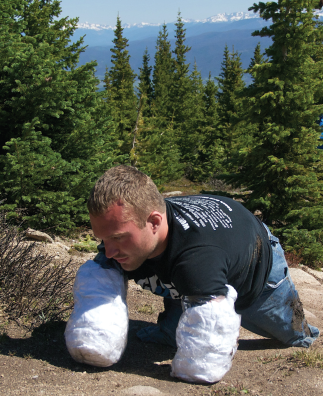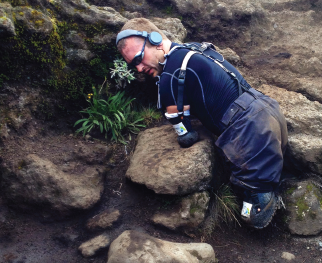By Damian Johnson
The most interesting part happened about three quarters of the way up the mountain,” said Kyle Maynard, discussing his ascent of Mount Kilimanjaro, the tallest mountain in Africa. “My arms and legs were starting to swell up so badly that we were forced to take the Western Breach.” For those unfamiliar with this formidable landscape, the Western Breach is a steep and icy gap on the mountain formed by lava flow thousands of years ago. It’s not the actual climb of the Western Breach that makes this area of the mountain so dangerous, it’s the falling rocks that give way as the glacial ice retreats and melts away. In fact, this section was temporarily closed in 2006 after a rockslide killed three people. “One slip or one rock and that could be it,” he said.
And for those unfamiliar with Kyle Maynard, those are the types of challenges he lives for, despite being born with a condition known as congenital amputation, which left both his arms ending at his elbows and both his legs ending at his knees. “Doctors didn’t really know what caused it,” Maynard says of the condition. “It wasn’t until I was 18 years old that a writer from Men’s Journal did some research on some of the causes of it. One of the main theories is that it’s a consequence of what’s called amniotic banding [amniotic band syndrome]. There is no doubt that life has been incredibly difficult at times, but I believe [my condition] is the greatest gift I’ve ever been given.”
“I believe that everyone has a mission and purpose in their life. Some people get caught up with wanting things to be perfect, but when you have a disability nothing is ever going to be perfect. You’re always going to have to figure out a way to adapt and overcome.”
In an interview that took place only a few weeks after Maynard and his Mission Kilimanjaro team summited the mountain, Maynard recalled his life growing up. He didn’t want to be the kid in a wheelchair sitting idly by, watching other kids play and compete in sports. “My parents taught me that everyone has a disability or a weakness. They raised me with the attitude not to focus on my disability and for that to be my identity, but to lead as normal of a life as possible. More importantly,” he added, “they let me dream. When I was nine I remember wanting to play for the Atlanta Braves. My parents never once told me I couldn’t do it. They just let me dream.”
When Maynard was in middle school his father encouraged him to join the wrestling team. A wrestler himself growing up, he used his son’s love of professional wrestling to peak his interest. “My dad tricked me,” Maynard said, laughing, “He told me it was going to be like being Hulk Hogan jumping off the top rope.” Maynard soon learned that the wrestling he was to learn in school—Greco-Roman—would be much different than the kind he watched on TV. Maynard, though, believes it was this sport that taught him to accept his life’s challenges more than anything else. “Wrestling is a great sport because you go out on the mat all alone and if you lose there’s no one to blame but yourself. Being defeated can be incredibly crushing, but when you win, the victory is that much sweeter. This is where my ‘no excuses’ message came from,” he said, referring to his 2005 New York Times bestseller, No Excuses.

Maynard started wrestling when he was 12 years old. Once a week he and his dad would show up for matches wherever they were hosted. “I soon started to hear what parents and coaches were saying,” Maynard said. “I’d overhear them saying that it was completely impossible for anyone without limbs to win a wrestling match, and I began to buy into that. Each week it got tougher and tougher for me to want to show up at all. But my dad would drag me into the tournaments kicking and screaming. I would lose in the morning, wait all day, then lose again at night and go home. And then he’d make me do it again the next weekend.” It took Kyle a year and a half—or about 25 matches—before he won his first match. “I’ll never forget it,” he said. “It was a great, great feeling, and it was good to prove people wrong.”
“I believe that everyone has a mission and purpose in life,” Maynard stated. “Some people get caught up with wanting things to be perfect, but when you have a disability nothing is ever going to be perfect. You’re always going to have to figure out a way to adapt and overcome.”
Kilimanjaro had been on Maynard’s radar for a while. An item on his “bucket list,” Maynard described the mountain and the land around it as one of the most incredible environments in the world. At the base is a rain forest, glacier ice at the summit, and nearly every possible climate throughout. “I had heard about [Kilimanjaro] for so long—the world’s tallest free standing mountain. I just had to finally climb it.” In April 2011 Maynard contacted Dan Adams, founder of Athletic Capital, which helped organize Mission Kilimanjaro. The two came together after realizing they shared a similar passion: helping others discover their inner potential. They then set out to share their vision with the communities of veterans and children with disabilities. “The vision is,” said Maynard, “that regardless of what’s happened to you, you can still choose to create the life that you want, not just be overcome with a sense of loss and mediocrity. Regardless of who you are, you can still fight for the things that you want.”

As Maynard and Adams began work on developing a team and creating the plan for Mission Kilimanjaro, they enlisted the knowledge and skills of a few of the most experienced climbers in the world (that happen to have disabilities.) Specifically, they enlisted the skills and advice of Erik Weihenmayer, a motivational speaker, outdoors adventurer, and board member for No Barriers USA, an organization that provides resources and programs to people with disabilities. Weihenmayer, too, knows about pushing beyond barriers. In fact, he is the only blind person to have summited Mount Everest. He is also one of only 100 mountaineers in the world to have climbed the Seven Summits—the highest mountains on each of the seven continents. “Weihenmayer has proven more powerfully than anyone,” said Maynard, “that there really are no barriers.”
So on January 7, 2012, Maynard and his team of eight began their 16-day climb of Mount Kilimanjaro. The purpose of the climb was to bring together both able-bodied and disabled civilians and military veterans in order to demonstrate that no obstacle is too great to overcome with an active, no-barriers lifestyle and mindset.
“The vision is,” said Maynard, “that regardless of what’s happened to you, you can still choose to create the life that you want, not just be overcome with a sense of loss and mediocrity. Regardless of who you are, you can still fight for the things that you want.”
“We set out pretty early in the morning,” said Maynard of their first day. “We boarded a bus to take us to the starting point, Machame Gate. It was pitch black and we couldn’t really see anything. Right as we were approaching the gate, the clouds opened and you could see the entire mountain. My heart felt like it was beating about 200 times a minute. It was an emotional feeling from both sides. I was really excited to climb but I was also thinking, What did I just get myself into?”
A typical day on the mountain included hiking five to seven hours. Some days were good and others were brutal, said Maynard. After several days into the climb his arms and feet began to swell badly and each step became more painful. This is when he and his team were forced to take the Western Breach. “We went through a tremendous amount of ice at about 19,000 feet,” Maynard said. “It was really difficult getting through and battling the elements.”
On the morning of their summit, the sun rose just as the team came over the crest. Among their group were two veterans who had been told they would never walk again, and the ashes of a third veteran, Cory Johnson, whose mother had contacted Maynard and revealed her son’s wishes to be placed at the top of the mountain. “Having them there with us and carrying Cory’s ashes was a huge honor,” said Maynard. “When we made it to the top it was absolutely amazing.”
Maynard switches gears, speaking of his life before the climb. “I’ve got to tell you another part of my story, probably the biggest part. A few years ago I was sitting in an airport waiting for a flight.” Maynard’s life at the time consisted of flying from city to city to give speaking tours about his book, No Excuses, to schools and organizations, living out of his suitcase and staying in different hotels each night. “I just wasn’t happy and I decided it was over; I wasn’t going to continue touring.”
While at the airport, he noticed two soldiers talking back and forth while looking at Maynard. “So I decided to go over and talk to them,” Maynard said. “Both of them were badly burned and I learned it happened to them while they were on a tour in Iraq.” The two veterans told him they had planned to kill themselves because their lives had changed so drastically and they couldn’t imagine going on with life in their current state. “On the day they planned to take their lives they saw my story on TV,” Maynard said. “From then on I decided that if I made a difference in their lives there was no way I was going to stop trying to make a difference for others.”
So what does the future hold for Maynard? As for any future challenges that will test his physical endurance, he said, “There is always something physical, but it’s not what I want to define me at the end of the day.” Maynard plans to continue touring, speaking, and offering motivation to those needing more push to reach their goals and dreams. “I want to keep spreading the message that you can choose the life you want,” he said. “Define your purpose in life and fight for something.” Maynard paused, adding, “I’m definitely interested in training and competing in Iron
Man triathlons.”






